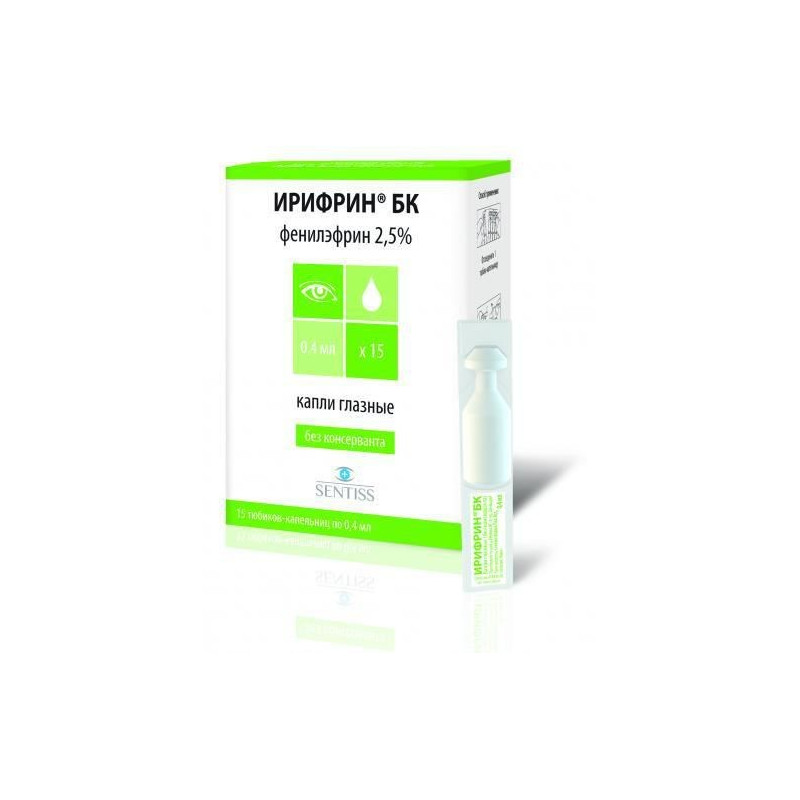



 All payments are encrypted via SSL
All payments are encrypted via SSL
 Full Refund if you haven't received your order
Full Refund if you haven't received your order
Release form
Irifrin BK. Eye drops
Packaging
In a disposable tube-dropper 0.4 ml solution of eye drops. In a package of laminated paper 5 tubes, droppers. In a pack of cardboard 3 bags of laminated paper.
Adrenomimetic. It has a direct stimulating effect mainly on α-adrenoreceptors.
With systemic use causes a narrowing of the arterioles, increases the OPSS and HELL. Cardiac output does not change or decreases, which is associated with reflex bradycardia (increased vagal nerve tone) in response to arterial hypertension. Phenylephrine does not increase blood pressure as sharply as norepinephrine and epinephrine, but it lasts longer. This, apparently, is due to the fact that phenylephrine is more stable and does not collapse under the influence of COMT.
When applied topically, phenylephrine has a pronounced vasoconstrictor effect, causes mydriasis, can reduce intraocular pressure in open-angle glaucoma.
In moderate therapeutic doses, virtually no effect on the central nervous system.
Pharmacokinetics
After oral administration, phenylephrine is poorly absorbed from the gastrointestinal tract. Metabolized with the participation of MAO in the intestinal wall and the "first pass" through the liver. The bioavailability of phenylephrine is low.
After topical application, undergoes systemic absorption.
Pregnancy
In animals in late pregnancy, phenylephrine caused fetal growth retardation and stimulated early onset of labor.
The effect of Irifrin BK in pregnant women is not well understood, therefore, it is necessary to use the drug in this category of patients only if the expected benefit to the mother exceeds the risk of the development of possible side effects for the fetus.
Lactation
In the case of the appointment of the drug during lactation, breastfeeding should be discontinued.
Active substance
Excipients
Disodium edetate 1.0 mg, sodium metabisulphite 2.0 mg, citric acid 1.16 mg, sodium citrate dihydrate.e., hypermmellose 3.0 mg, water for injection q.s.
When carrying out an ophthalmoscopy, single instillations of a 2.5% solution of Irifrin BK are used. As a rule, to create mydriasis, it is enough to inject 1 drop of a 2.5% Irifrin BK solution into the conjunctival sac.
The maximum Midriaz is reached in 15-30 minutes and remains at a sufficient level for 1-3 hours. If it is necessary to maintain mydriasis for a long time, after 1 hour, repeated instillation of Irifrin BK is possible.
For diagnostic procedures:
When iridocyclitis
Schoolchildren
For the prevention of accommodation spasm in the period of high visual load, 1 drop of Irifrin BK is buried in the evening before bedtime.
3 times a week in the evening before bedtime.
During the day, depending on the load.
With hyperopia with a tendency to accommodation spasm under high visual load
In the treatment of false and true myopia
Local
Conjunctivitis, keratitis, periorbital edema, eye pain, burning during instillation, tearing, blurred vision, irritation, discomfort, increased intraocular pressure, blocking the anterior chamber angle (with a narrowing angle), allergic reactions, reactive hyperemia. Phenylephrine may cause reactive miosis the next day after application. Repeated instillations of the drug at this time may produce a less pronounced mydriasis than the day before. This effect is more common in older patients.Due to a significant reduction of the dilator of the pupil under the influence of phenylephrine 30-45 minutes after instillation in the anterior chamber moisture, pigment particles from the iris pigment sheet can be detected. .
Systemic
Contact dermatitis.
Since the cardiovascular system
Heart palpitations, tachycardia, arrhythmia, high blood pressure, ventricular arrhythmia, reflex bradycardia, occlusion of the coronary arteries, pulmonary embolism.
Drug interaction
The mydriatic effect of phenylephrine is enhanced when used in combination with topical administration of atropine. Due to increased vasopressor action, tachycardia may develop.
The use of Irifrin BK for 21 days after discontinuation of patient intake of monoamine oxidase inhibitors and tricyclic antidepressants should be carried out with caution, as in this case there is the possibility of an uncontrolled rise in blood pressure.
The vasopressor effect of adrenergic agents can also be potentiated when used together with tricyclic antidepressants, beta-blockers, reserpine, guanethidine, methyldopa and m-anticholinergics.
Irifrin BK can potentiate the inhibition of cardiovascular activity during inhalation anesthesia as a result of increased sensitivity of the myocardium to sympathomimetics and the onset of ventricular fibrillation.
Concurrent use with other sympathomimetics may increase the cardiovascular effects of phenylephrine.
The use of phenylephrine may cause a weakening of concomitant antihypertensive therapy and lead to an increase in blood pressure, tachycardia.
Symptoms: overdose are anxiety, nervousness, Dizziness sweating, vomiting, rapid heartbeat, weak or shallow breathing.
Treatment: in case of the occurrence of the systemic action of phenylephrine, the undesirable effects can be stopped by using alpha-adreno-blocking agents, for example, from 5 to 10 mg of phentolamine intravenously. If necessary, the injection can be repeated.
At room temperature (up to 25 ° С) protected from light and inaccessible to children. Do not freeze.